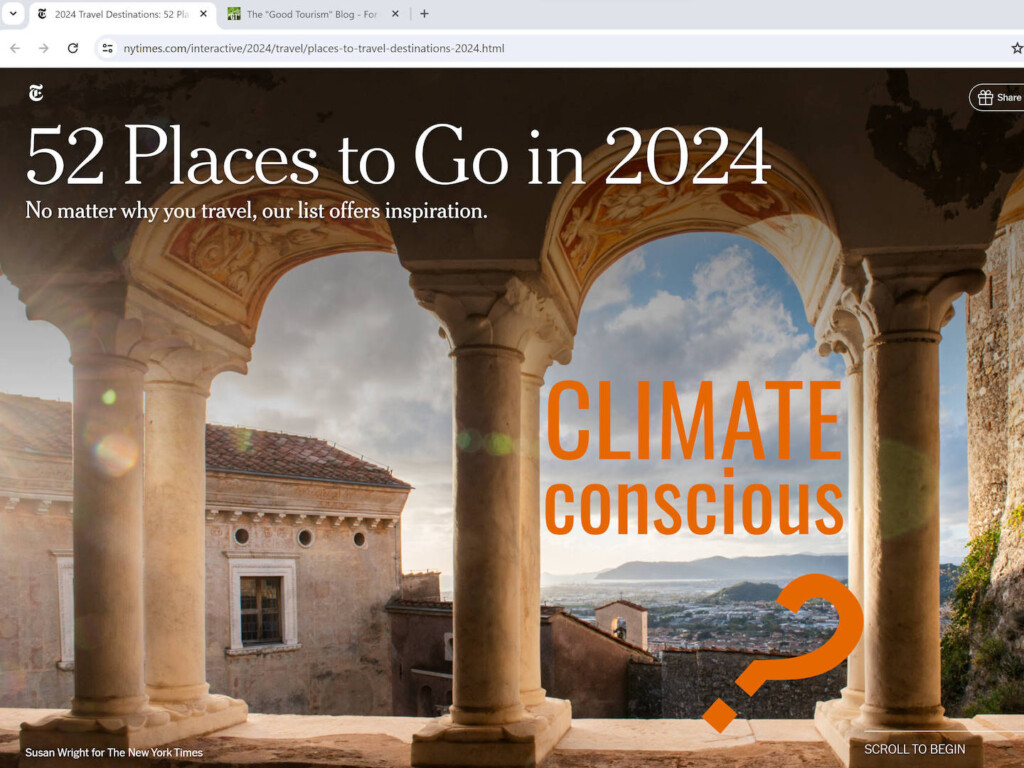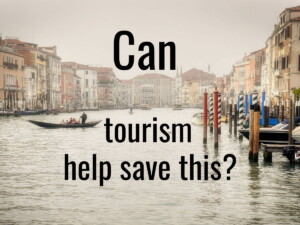A climate-conscious reading of ‘The New York Times’ list of ‘52 Places To Go in 2024’

Climate action advocate Herb Hiller offers a climate-conscious reading of The New York Times’ list of ‘52 Places to Go in 2024’.
It is his second “Good Tourism” Insight.
[You too can write a “GT” Insight.]
People love to travel but keep getting shoved around. We live in an epoch of catastrophic global warming, which frequently forces us to change our travel plans. (We haven’t yet reached mid-winter in the northern hemisphere, but freakish cold storms are already diverting us from intended destinations.)
In mid-January, Storm Isha rerouted thousands of air passengers, many to entirely different countries, like undocumented aliens at the Mexican-US border flown by the governors of Florida and Texas to northern sanctuary cities to score political points.
You’re on a passport-free domestic flight maybe a half-hour from Edinburgh to Bristol when Isha diverts your Airbus to Paris, where you can’t leave the airport without a passport. You have to sleep overnight on the terminal floor, and maybe wind up on a cross-Channel train to get home two days later.
Storm Jocelyn was following.
Contents
‘[A]bsolutely gobsmackingly bananas’
Leading climatologists find that global warming is getting worse faster. One calls the acceleration “absolutely gobsmackingly bananas”. Others say the evidence isn‘t in yet.
- There were more tornadoes in 2023 than the average between 1991 and 2022.
- Last year, the hottest ever recorded, “Took Chaos to a New Level”, blustered a headline in The New York Times.
- Travel advisors are sending summer sun seekers to cool Scandinavian destinations instead of the Meditteranean.
We know these things.
We also know that tourism, which by definition depends on transportation — and favours marketing to long-distance air fliers — worsens greenhouse gas emissions; by as much as 11 percent per year, Bloomberg reports.
Yet anyone whose travel was ruined when Southwest Airlines, by itself, cancelled 16,900 flights during the 2022 holiday season, and who was again flying over the 2023 holiday season, would surely have found the first peak year of airport hassles since 2019 only grudgingly acceptable.
Travellers don’t always mean what they say about climate action
While more than half of people surveyed told Time that their vacations’ environmental impact was at least somewhat important to them, that concern ranked below cost, dining, “nature”, and socialising. The World Travel & Tourism Council, a marketing organisation, ranks traveller concerns higher.
Meanwhile, more of those who advise travellers, such as the high-end Virtuoso consortium of travel advisors and the aptly named Intrepid consortium with its global reach, at least claim to be dedicated to sustainable tourism.
Personal forecast: Our new year, 2024, will witness the calving of mass tourism, like glaciers melting away from surrounding overheated seas. That, or a still further collapse of our already destabilised natural weather systems.
I believe we can count on human intelligence trumping ideology. Because, look around: The worsening effects of climate change are a problem everywhere.
By the end of 2024, I predict anyone planning for leisure travel will be conditioned by how our choices qualify as climate action.
A matter of ethics? More likely a matter of experiencing the budget-busting anxiety of climate impacts, or of knowing someone who has.
Don’t miss other “Good Tourism” content tagged ‘Tourism and climate change’
Our trips can help us rebalance Earth’s prospects
The New York Times influential list of “52 Places to Go for 2024” arguably points travellers to choices that advance climate action.
Many if not most of the list’s destinations are near population centres, so that visitors don’t have to fly in. Consider residents of Almaty, Baltimore, Santiago, Chile, Singapore, Vienna, or wherever people live in high concentrations who can travel among wonders of the world nearby.
While the list barely mentions climate change, its 52 choices about where to go tick most of the right boxes; certainly not all, because NYT readers tend to be affluent and can afford to fly wherever they wish.
Yet in large part the choices are about nature and heritage with little that’s newly built to attract tourists that isn’t already meant for locals. In Manchester, England, as in Kansas City, USA visitor spending tends to stay in these local economies.
New destination transportation options also support climate action. The subway in Quito is the sixth among South American capitals. Also new across the 52 places are surface rail, electric ferries, cable cars, and multi use trails.
Lodgings of notice are almost everywhere locally scaled.
Yet destinations at their official travel websites rarely talk about climate action. Even Oregon, greenest among all US states, says nothing about it on its website.
Missed predictions
The Travel Foundation, a non-governmental organisation, along with other British travel & tourism stakeholders, considered this in 2009 when they looked ahead to “Tourism 2023 — towards a sustainable travel and tourism industry”.
With research backed by KPMG, the Foundation and its partners concluded:
“[B]y 2023, public awareness of the impacts of all forms of travel will be much higher than today. Over the next 15 years, the impacts of climate change will increasingly be felt and reported on in diverse forms of new media. Leaders in business and politics are expected to accelerate their action due to the urgency of the task ahead.”
Maybe their prediction about “new media” was on target, but the report’s hopeful forecast never gained acceptance for industry action.
That’s explained in a follow-up in 2023:
“[T]here was never enough noise for the tourism industry to listen and act. For the last decade, the tourism industry has, for the most part, continued business as usual, with a primary focus on growth above all else.”
The follow-up is blunt about what tourism and its policymakers must do by the end of this decade if, “like every other human activity, it’s to achieve net zero greenhouse gas emissions by 2050”.
New challenge
The Travel Foundation lays out a challenge for change that now urges:
- More governments including international aviation emissions in their Paris Agreement greenhouse gas reduction plans;
- Tourist boards targeting short-haul customers;
- Travel companies offering net zero products;
- Governments investing in greener forms of transport and the travel industry adopting and promoting them;
- Everyone relying less on offsetting as a ‘sticking plaster’ solution, focusing instead on decarbonisation;
- Everyone considering equity and fairness and recognising that some destinations are more ready for the scenario than others; and
- Slowing the expected rapid growth in aviation by limiting long-haul flights.
The Travel Foundation says it’s time to act:
“[O]ur report is not a prediction, it’s a last chance.”
It also sounds like what a careful reading of The NYT’s list is telling travellers.
What do you think?
Share your own thoughts about tourism and climate change in a comment below. (SIGN IN or REGISTER first. After signing in you will need to refresh this page to see the comments section.)
Or write a “GT” Insight or “GT” Insight Bite of your own. The “Good Tourism” Blog welcomes diversity of opinion and perspective about travel & tourism, because travel & tourism is everyone’s business.
“GT” doesn’t judge. “GT” publishes. “GT” is where free thought travels.
If you think the tourism media landscape is better with “GT” in it, then please …
About the author

Herb Hiller, writer and climate action advocate at The Climate Traveler, has “progressed from travel insider to a solutions-driven critic of mainstream tourism”.
Mr Hiller has lived in the Caribbean region and the US states of Florida and Georgia, working much of his career on multi-modal mobility. He initiated the Caribbean Tourism Research Center in Barbados; led the revival of the Florida state bicycling and B&B movements; inspired the Great Florida Birding Trail; and wrote the cover story for Florida Trend in 1996 that called for the newly-established Visit Florida DMO to go green.
Two of Herb’s books have won top honours in their fields. A fourth is near completion.
Featured image (top of post)
This is a cropped screen capture of a cover page of the online article ‘52 Places to Go in 2024’ by The New York Times. As indicated on the screen capture, the image used by NYT is by Susan Wright. “GT” added the words “CLIMATE conscious?” to the screen snip.





